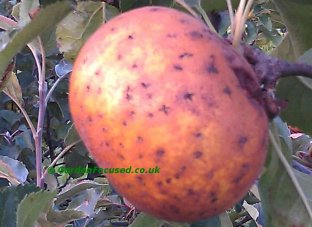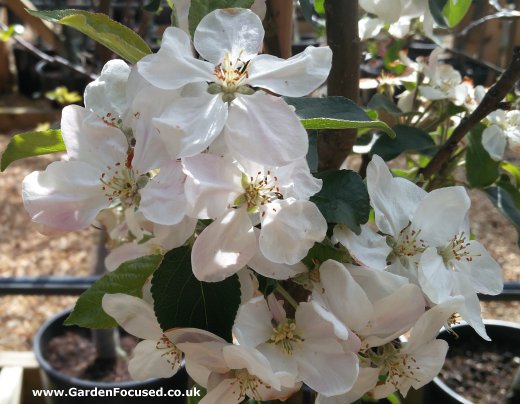PARENTAGE OF SCRUMPTIOUS
The parents of Scrumptious are Golden Delicious and Discovery.
APPEARANCE AND TASTE OF SCRUMPTIOUS APPLES
The medium-sized apples are a very appealing shade of red which is over most of the surface of the apple. The sunnier the position the redder the apples turn. The skin is thinner than average making eating them easy for all ages.
This is definitely a sweet apple but somehow it manages to escape being sugary because of the several background flavours which depend on the conditions the trees are grown in.
The flesh is creamy white and crunchy, almost all who taste this variety are pleasantly surprised by the taste and texture. The apples are produced earlier in the season compared to many other varieties but have the advantage that they will stay on the tree for two weeks and still remain in good condition. They will store for a relatively short time when picked, one or two weeks at most.
The blossom is produced neither late nor early in the season but if a late frost does occur they are resistant to damage. This makes Scrumptious particularly suited to cooler parts of the UK. It is self-fertile and does not need a pollination partner to produce a good crop of fruit. It is also an excellent pollination partner for the majority of other apple trees.
GROWING SCRUMPTIOUS APPLE TREES IN THE UK
The natural form of Scrumptious is a slightly arching and spreading, making it an attractive feature in all gardens.
This apple tree is a partial tip bearer which means it may need to be pruned slightly differently from most apple trees. Click here for more details. In reality though, Scrumptious is a heavy cropper and normal pruning techniques suit it just fine. It is however not a particularly strong growing tree and pruning should be restricted in most years.
Scrumptious apple trees are slightly less vigorous compared to many others and this makes them good choices for container growing and espaliers.
In all other respects they can be grown as normal apple trees, see here.
PESTS AND DISEASES OF SCRUMPTIOUS
Scrumptious has an impressive record as far as disease resistance is concerned. It shows excellent resistance to scab, the scourge of many apple tree growers. Its one weakness is bitter pit which is described below.
BITTER PIT
This variety is prone to bitter pit and the symptoms are small brown / black marks on the surface of the skin. Cutting the apple in half reveals that under the brown surface marks the flesh of the apple is also stained. The picture shown below is rather extreme but it does illustrate the effects very clearly.

The apples quickly become bitter and inedible. This condition is caused by an irregular supply of water at the roots. Mulching under the full canopy area and just beyond greatly helps. For a full description of bitter pit, click here.
BUYING A SCRUMPTIOUS APPLE TREEE IN THE UK
The majority of online fruit tree specialists sell Scrumptious on a variety of rootstocks. It is also increasingly available in garden centres although rarely seen for sale in the discount stores.
If you prefer us to recommend a supplier for this variety then we suggest Crocus who sell it on M9 rootstock with a 5 year’s guarantee. Click here for their page which contains more information about buying online.
Remember that all apple trees need a stake to support them for the first couple of years and some require staking for life. So if you haven’t got a stake and a tie for your new tree then buy one when you order the tree for convenience. Scrumptious is a an average variety as far as vigour is concerned so M27 and M9 rootstocks will need permanent staking. Grown on M26 rootstock it will only require staking if conditions in your area are windy or the soil conditions are poor.
ALTERNATIVES TO SCRUMPTIOUS APPLE TREE
When considering alternatives to this variety the key features to look for are an early / mid season apple tree, good looking red skin, good disease resistance. It should also be partially or fully self-fertile and have excellent taste and aroma. The following have some or all of those characteristics:
- RED FALSTAFF – a widely available sport of Falstaff. Very similar to Fiesta in almost all respects, we would say that Fiesta tastes slightly better but it’s a very close call.
- SUNSET – slightly more acidic but only slightly. Tip top disease resistance. This is our choice for a container grown tree or for smaller gardens, the apple size is slightly smaller than average.
- LAXTON’S SUPERB – one of the top three best tasting apples of all time in our view. As sweet as Scrumptious and lots of apple flavour. This variety has no drawbacks, a great tasting apple with superb looks and good pest and disease resistance. Produces apples slightly later in the year.
The full list of apple tree varieties which we have reviewed is listed below. Select any one of them and then click the “More Information” button to be taken to the in depth review:
SCRUMPTIOUS FLOWERING AND HARVEST TIMES:
The average flowering time (optimum time for pollination) and date when fruits are ripe in the UK for the Scrumptious apple tree are set out below. If you have set your home town we can give you a more accurate estimate, if you have not set your home town (do it now by clicking here) the dates below will be the average for the UK.
Your town has not been set, the average main flowering time for Scrumptious in the UK is the first week of May. Fruit will be ready for harvesting in the first week of September. Click here if you want to set the dates to your home town.

![]()
Scrumptious blossom
Flowering and fruit picking dates vary according to the weather in any particular growing season so the above dates may well change slightly from one year to the next. The flowering date above is when the apple tree produces the maximum number of blossoms, it will also produce blossom, although less, a week or two either side of the date given.
COMMON POLLINATION PARTNERS FOR SCRUMPTIOUS
Scrumptious is fully self-fertile but in years with poor conditions it can benefit from a nearby pollination partner. This variety is in pollination group 3 and is an excellent pollination partner for other apple trees. Suitable varieties include the following:
- Alkmene - pollination group 2, self-sterile, eater
- Arthur Turner - pollination group 3, self-sterile, cooker
- Beauty of Bath - pollination group 2, self-sterile, eater
- Bountiful - pollination group 3, self-sterile, cooker
- Braeburn - pollination group 4, self-fertile, eater
- Charles Ross - pollination group 3, partially
self-fertile, cooker and eater
- Court of Wick - pollination group 3, self-sterile,
eater and cooker
- Devonshire Quarrenden - pollination group 2, partially self-fertile, cooker
- Discovery - pollination group 3, self-sterile, eating and
cider
- Dumelows Seedling - pollination group 4, self-sterile, cooker
- Egremont Russet - pollination group 2, partially
self-fertile, eater and cooker
- Ellison's Orange - pollination group 4, partially self-fertile, eater
- Falstaff - pollination group 3, partially self-fertile, eater
- Fiesta - pollination group 3, partially self-fertile, eater
- Golden Delicious - pollination group 4, partially self-fertile, eater and cooker
- Granny Smith - pollination group 3, self-fertile, eater and cooker
- Greensleeves - pollination group
2, self-fertile, eater, cooker, juice
- Grenadier - pollination group 3, partially self-fertile, cooker
- Honeycrisp - pollination group 4, self-sterile, eater
- Howgate Wonder - pollination group 3, partially self-fertile, cooker and eater
- Idared - pollination group 2, self-sterile, eater
- James Grieve - pollination group 3, partially self-fertile, cooker
and eater
- Kidds Orange Red - pollination group 3, self-sterile, eater
- King of The Pippins - pollination group 4, partially self-fertile, eater and cooker
- Laxtons Superb - pollination group 4, partially
self-fertile, eater
- Lord Derby - pollination group 4, self-sterile, cooker
- Lord Lambourne - pollination group 2, self-fertile,
eater and cooker
- Newton Wonder - pollination group 4, partially self-fertile, cooker
- Peasgoods Nonsuch - pollination group 3, partially self-fertile, cooker
- Rajka - pollination group 4, self-sterile, eater
- Red Windsor - pollination group 2, self-sterile, eater
- Red Falstaff - pollination group 3, partially self-fertile, eater
- Reverend W Wilks - pollination group 2, self-fertile, cooker
- Sops in Wine - pollination group 3, self-sterile, juicer
- Spartan - pollination group 3, self-fertile, eater
- Sunset - pollination group 3, self-fertile, eater
- Tydemans Late Orange - pollination group 4, self-sterile, eater
- Winston - pollination group 4, self-fertile, eater
- Worcester Pearmain - pollination group 3, partially self-fertile, eater
SUMMARY CHARACTERISTICS OF SCRUMPTIOUS
USE: Eating
SKIN COLOUR / TEXTURE: Mainly red, orange / green background
FLESH COLOUR: Creamy white
TASTE AND TEXTURE: Sweet without being sugary, lots of
background flavours, crisp and crunchy
FRUIT SIZE: Average
STORAGE: Two weeks
SUITABILITY FOR CORDON / ESPALIER GROWTH: Yes
TREE SIZE: Average size depending on rootstock and conditions
REGULARITY OF CROPPING: Very regular
READY FOR PICKING / HARVEST:
First week of September
POLLINATION: Group 3, fully self-fertile an excellent pollination partner for many other varieties.
AWARDS: RHS AGM
SPECIAL FEATURES: Superb looking and tasting apple, easy to grow, good disease resistance
Rootstocks and Size
Guide to Planting
Care Plan
Pruning Apple Trees
Harvest and Storage
Pests and Disease
Pollination Groups
SCRUMPTIOUS APPLE TREE
Scrumptious was bred in Kent and released in the early 1980s. The man responsible was Hugh Ermen, who was also raised several other popular modern apple tree varieties such as Red Devil and Hertfordshire Russet.
It is one of a very few select varieties to have received the RHS Award of Garden Merit in the last 20 years, which it still retains. Taste, texture and looks are well above average. It is especially useful because it produces apples slightly early in the season which can be harvested over two weeks with no deterioration in quality. It is an ideal choice for novice gardeners, requiring very little attention.